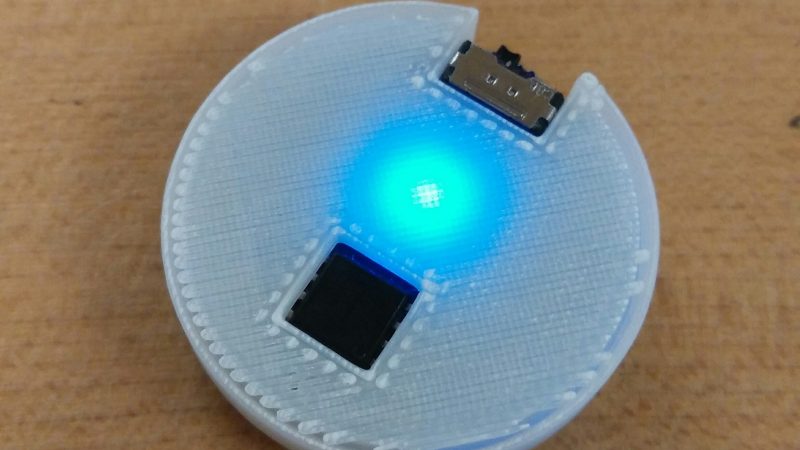Navy SEALs and other highly trained special forces operators all know a simple, basic fact – you’ve got to breathe to live. That seems self-evident, but breathing control is immensely important to being able to perform at a high level in stressful situations. But even if you never anticipate being under fire, you can learn the SEAL way of breathing with this visual aid.
Lest you think that Box Breathing, also known as the four-square breathing technique, is some sort of New Age nonsense, recent research has uncovered the neurological basis for the feeling of calm that can come over someone taking slow, deep, even breaths. But in the heat of the moment, remembering to square your breaths can be a little difficult. [Lim Han Yang] decided that a portable visual cue could help, so he put an ATTiny85, an LED, and a coin cell battery on a tiny circular PCB and spun up a simple translucent dome out of PLA. The blue LED has a soothing appearance behind the diffuser as it goes through a 16-second cycle, ramping up in brightness for four seconds, holding steady for four, then dimming and finally staying dark. The idea is to breathe in sync with the light to get relief from stress.
No build files are posted yet, but we hope to see them soon – we can think of a few people this would benefit greatly. In the meantime, if you’re still looking for that New Age breathing experience, you can always breathe with the psychedelic flowers.





















no vid of it in action?
I hate going to the dentist, and while ‘in the chair’ recently I stumbled on to this breathing ‘trick’ – no science, no technology, I simply focused not on the activity in my mouth, but instead on my breathing – just focusing my mind on taking slow, deep breaths and slowly exhaling helped me not get stressed in the dentist chair.
Of course the Nitrous helped ;^), but the breathing seemed to have, as described above, acalming effect on me in what is typically a very stressful situation.
I picked this up somewhere between Crowley and old Army manuals. Great for shooting, lowers your heat rate!
*heart rate even
I use it at the other end of resp. rate. Heard about it on the radio. Helps bike up one of the steepest streets in town, I live on the top. I will sound like a classic two cylinder steam locomotive with quartered drive going slow.
Discovered it 50 years ago in martial arts. It’s an ancient technique. I still teach it to my students. You can use it to cal or to increase focus. With a little practice you can use it any time or place. It does also work to keep from gasping for air when you need a lot in a hurry.
Been thinking about doing this at some point (granted some app not HW). Can [Lim Han Yang] confirm this thing does not get ignored after a while and it becomes something in your background that your brain removes?
Looks like an interesting technique and a simple but useful project. It probably can be done with a 555 but using a microcontroller like the ATTiny85 makes a lot of sense if you have one laying around. But I don’t and have quite a few 555, I think I’ll use a cheap analog meter instead of a LED. A 16 second period will charge a capacitor for 4 seconds, maintain 4 seconds, discharge 4 seconds and keep uncharged 4 more seconds. It won’t be as precise as a microcontroller but that’s not needed for this application.
If I had 0 components then I might go with the microcontroller option. But I’m old an using something that rivals the power of the first computers to flash an LED rubs me the wrong way even if it now makes perfect sense design wise.
Yes, but can you make it dim with just a 555?
With a 556, using one timer in the charge/discharge mode described above, and the other in PWM mode, I could see this being attainable. :)
Actually I myself was thinking about doing this as well, glad to see I’m not alone.
http://www.circuitstoday.com/saw-tooth-wave-generator-using-ne555
or similar, adjust ramp times.
I generally agree that microcontrollers shouldn’t be used when a simple circuit will suffice, but I see a case for an Arduino here. Four-second phases might be too long – or too short – for some people. A microcontroller would easily allow you to add adjustability to this, just by tweaking the code. Or you could support a simple push button UI to change the interval. That would be hard to achieve with a 555 in this form factor. Remember, this thing is about the size of a quarter.
This is a great technique for stress relief and focus. The trick is to remember to do it. That said, would be cool if this gizmo was wearable in a wrist watch form and “sensed” your stress level then vibrated to tell you to look into the light.